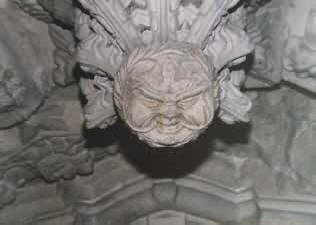The Green Man

- A Green Man at Rosslyn Chapel, near Edinburgh.
Although the Green Man first appeared in the Middle Ages, his roots can be traced to Roman, Greek, and pagan myths. Carvings of the ancient god can be found across Britain.
His significance puzzles historians. A pagan symbol of fertility, or of eternity and rebirth? His image is all around us: like mushrooms and blackberries, the more you look, the more you find.
Gardens and cathedrals are his most popular haunts – and those locations are almost a millennium apart. The Green Man first appeared in the Middle Ages. He was descended from Dionysus (Greek), Bacchus (Roman) and Osiris (Egyptian).
He personified Robin Hood, then the Green Knight in the Arthurian legend of Sir Gawaine, then Dante’s Eternal Gardener. Perhaps he planted Yggdrasil, the ash tree central to Norse mythology.
The Green Man is immortal. He has had, to date, four distinct lives: in art, in architecture, in nature and in today’s environmental consciousness.
He is depicted in early illuminated manuscripts, such as the Book of Kells, as a grinning head surrounded by foliage, usually yew or oak. Later, carvings of the Green Man appeared in many of the cathedrals of northern Europe. And here is the mystery. Why is a pagan symbol so prominent in great houses of religion?
Rochester in Kent and Hastings in Sussex stage annual “Jack in the Green” festivals, spring counterparts to harvest festivals in which a man dressed in leaves is paraded through the streets, and it is considered lucky to purloin a leaf or two.
In England, east-coast cathedrals are rich in green men, particularly Ely, Norwich and Lincoln. Ely, though vandalised by Cromwell, has ten green men, including one who sprouts foliage from his ears. Southwell Minster has nine men, including an “unmasked” one.
Most green men spew foliage from their mouths, usually oak or vine leaves. Historians believe that unmasked faces, without such foliage, have done their duty and are free to look beyond the mundane. They come out, as it were.
At Lincoln, the Green Man is not free. On a column on the west front of the cathedral, he is trapped in writhing coils of vegetation. Norwich’s Green Man looks inscrutable in the east cloisters, his face fringed with gilt oak leaves. Carlisle cathedral has several. So does Glasgow cathedral, and Melrose Abbey has a particularly hideous one.
Rosslyn Chapel near Edinburgh, built around 1446 and with Masonic and Knights Templar associations, has more than anywhere in the world: over 100. Many are close to the Gothic windows, where the foliage from the Green Man’s mouth blends into a fenestral surround.
In his third reincarnation, the Green Man witnessed environmental destruction and slumbered. In the Industrial Revolution and the Victorian era he went back to the garden – in the wrought-iron gates of Kew, on urns at Biddulph Grange in Staffordshire. This was the era when botany became a respectable science. And in the past 30 years, the Green Man awoke and took charge of our ecological consciousness. He invented the Green Party, drew our attention to rain forests and recycling, developed cycle lanes and cheap public transport. And he paved the way for the Gaia theory, that the planet is a self-regulating organism which will always survive, despite mankind’s puny attempts to destroy it.
The Green Man, 2,000 years old, is alive and well and living in a garden or cathedral near you.
Rosslyn’s famous Prentice Pillar, an extravagant representation of the Tree of Knowledge, cost the mason his life when the master mason found he’d been upstaged. Carvings of cacti and sweetcorn suggest the chapel’s founder, Sir William Sinclair, crossed the Atlantic before Columbus.
Adrian Gardiner
Saturday, 19th May 2001
The Scotsman
© The Scotsman Publications Ltd